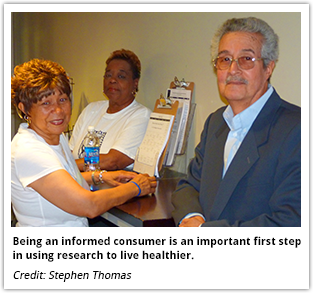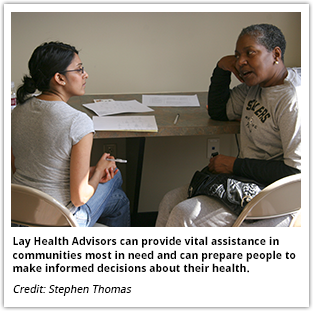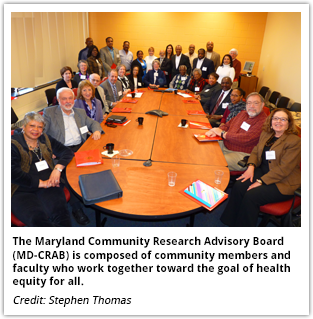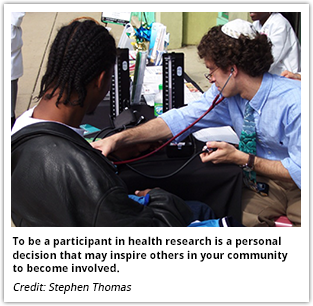Getting Involved
Often, scientists and health researchers are the people who generate ideas and ask the questions in research, but many types of research can and should involve communities. Today, more researchers work with community members to identify research questions, to help them conduct studies that meet community needs, and to provide results to groups who can use those results to improve their own community.
There are many different ways to become engaged with researchers. We will share some ideas for you, your family, and your neighbors to consider.
Building on what you learned in Unit 2 about participating in research and the informed consent process, you may be ready to consider taking part in a study. Did you know that there are other ways to become involved?

Informed Consumer
Whether you decide to participate in research or not, health research impacts you. You doctor makes recommendations based on health research. You and the people around you make decisions about how to keep healthy, based on news reports and articles in magazines all grounded in health research. Yet, understanding health research can be challenging.
You can be a leader for yourself and your family by learning more about how to interpret health research reports. Learn to ask informed questions. Who conducted the research? Was the research done on humans or animals? How many people participated in this study? Were the participants like you or different? Is there other research that supports the reported findings? All health research is not the same. Studies completed with human subjects, with large and diverse samples, and with control groups are generally more reliable. While the headline may read "Diet rich in Vitamin B is Secret to Long Life," you may need to find out more before you make the decision to change your diet just yet.
Where to Find Credible Health Information?
- Your local library or librarian
- Your doctor's office
- The National Library of Medicine
- The Centers for Disease Control and Prevention
Resources
Learn more about how to read about research in the news at: http://www.ncbi.nlm.nih.gov/pubmedhealth/behindtheheadlines/how-to-read/
Go to the Building Trust website page "Becoming an Informed Consumer."

Lay Health Advisors
Community-engaged researchers are interested in working with people in the community to make their research more valid and relevant to the people that they are trying to help. For this reason, more and more researchers are looking for community members to help with recruiting participants, collecting data, helping to understand data, and helping to share the knowledge gained from research with the community. Some of these positions are paid and others are on a volunteer basis. You could make a difference in your community by contributing your knowledge, as an expert in your community, to the pursuit of science.
Another way that researchers engage community members is as lay health advisors, either in paid or volunteer positions. Many people in public health believe that a good way to create better health for all is to identify individuals who live in the community, who are already trusted friends and neighbors, and who understand the local culture, and actively train them to be knowledgeable about specific health issues. Such community leaders can serve as advisors and be a health resource to others. They can also work with research teams to educate community members about a health issue or disease in a more formal way. Lay health advisors may have different roles in different communities. They can also be called by different names including, "community health workers" or in Latino communities, "promotores de salud."
Resources

What is a Community Advisory Board?
A Community Advisory Board (CAB) is composed of community members who share a common identity, history, symbols, language, or culture. Many studies create their CAB to help them do the following:
- Act as a liaison between researchers and community;
- Represent community concerns and culture to researchers;
- Assist in development of study materials;
- Advocate for the rights of human subjects;
- Consult potential participants about enrollment in the research; and
- Disseminate results of the research to the community.
Most CABs serve a specific study. For instance, in Pittsburgh, there is a CAB that has worked for more than 20 years with researchers on a study of HIV/AIDS. The Pitt Men’s Study CAB is composed of people in the local community who are affected by HIV/AIDS including some members who are HIV positive, members who work with men at risk of the disease, service providers, and others. Over the years, the CAB has provided many opportunities to educate researchers about community concerns, educate community members about HIV, advocate for programs and policies that are important to men with HIV/AIDS, and identify research needs that are then studied by the research team.
At the University of Maryland Center for Health Equity, we have the Maryland Community Research Advisory Board (MD-CRAB), which operates differently from most CABs. The MD-CRAB is not associated with any one study but has two larger goals: to build trusting relationships between racial and ethnic communities and researchers and to help ensure that these same communities benefit from research. The aims of MD-CRAB are to:
- serve as a "think tank" generating ideas suitable for research that come from the real experience of people in greatest need of the lifesaving results of research;
- increase awareness of both the risks and benefits of participating in public health and medical research, including clinical trials;
- serve as a forum for researchers to present their ideas so that MD-CRAB members may offer feedback and recommendations to research teams, provide opportunities for them to learn about the African American and Latino community and cultural norms, and enable community members to shape the development and implementation of research projects; and
- ensure that policy decision makers hear the voices of people who come from underserved, poorly served and never served neighborhoods across the state of Maryland.
How can I become part of a CAB?
There are several ways you might learn about serving on a CAB. If you live near a university with a medical school or a school of public health, you may want to look on their websites for their listed research centers. Across the United States right now, we have a network called the Clinical and Translational Science Awards (CTSAs) program that includes about 60 academic institutions conducting medical and health research, and working with community members and health care providers to apply what researchers learn to improve health. That consortium (https://www.ctsacentral.org/institutions) includes a number of sites that have CABs. Finally, if you belong to organizations that have particular focus on a health topic or disease, you may want to share with that organization that you would be interested in serving on a CAB; other researchers will reach out to such organizations for members.
Resources

What is an IRB?
An Institutional Review Board (IRB) is a committee responsible for reviewing research studies involving human subjects. The IRB’s priority is to ensure that people participating in research are protected from harm and are treated ethically. The IRB must review, approve, and monitor all research involving humans, including clinical trials, behavioral studies, survey taking, focus groups, etc. The IRB examines all documents used for informed consent, reviews how the benefits and risks of the research are described, and requires that researchers share specific information with potential participants.
Who can be a community member of an IRB?
An IRB must include members who are not researchers and who come from outside the university or hospital that runs the IRB. An IRB community member does not have to have a background in research. He or she may bring experience or knowledge about diseases, communities, or other issues that can help the IRB.
Resources

How to Connect with Researchers
The Building Trust website is a good place to start if you are ready to become involved in research as a subject. Think about what kind of research might be right for you. Will you be willing to take an experimental drug? Try a new exercise plan or diet? Would the topic of the research matter to you? Making the decision to participate in research is an individual and personal choice. Some may prefer to contribute to research in other ways such as becoming a member of a community advisory board or institutional review board. Others may be happy to simply become better informed about research and research findings to help them to make decisions about their health.
If you do decide to become a research participant, you don’t have to wait to be asked. There are opportunities to become involved all around you. Once you become aware of research, you will see advertisements everywhere, in the paper, on the bus, even on television. You can also talk to your health professional or make use of one of several website services that try to match participants and researchers. Go to the Building Trust website page “Being a Participant” where you will find ideas about how to connect with researchers who need your help.
Resources
http://www.nih.gov/health/clinicaltrials/index.htm
Be sure to review Building Trust Unit 2 "Informed Decision-Making" before agreeing to participate in any study.

Additional Resources
-
An IRB Public Member's Education
-
Center for AIDS Prevention Studies Community Advisory Board (CAPS)
-
Community Members of IRBs
-
CTSA Consortium
-
Department of Energy IRB
-
Diabetes Public Health Resource
-
Manual for Community-Based Participatory Research
-
Maryland Community Research Advisory Board (MD-CRAB)
-
Research and the Community IRB Guide
-
Rocky Mountain PRC CAB
Important Question
How are YOU most likely to get involved in research?






